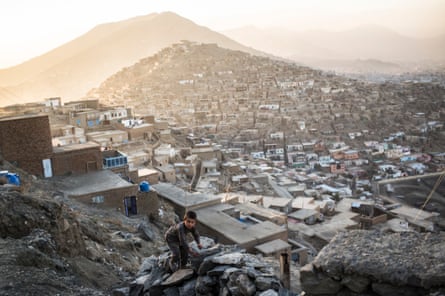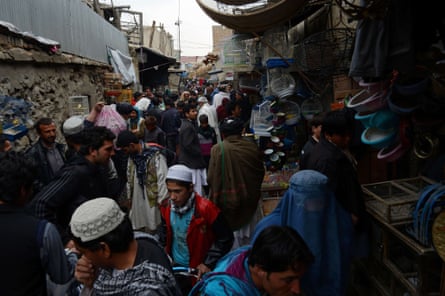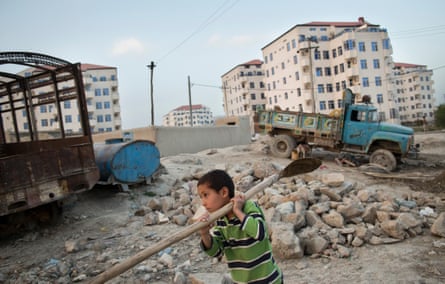Seen from above, Kabul looks like a city bursting at the seams. Cars clog the streets, negotiating for space with street vendors and donkey carts. At the fringes, crude houses pepper the hillsides and the valley along the river, spreading far beyond what a short time ago were the edges of the Afghan capital.
Over the past decade, Kabul has become one of the world’s fastest-growing cities. The toppling of the Taliban in 2001 and the hope of increased security and economic possibilities enticed many Afghans to move here: people displaced by fighting in the countryside, refugees returning from Pakistan and Iran, and hordes of labourers simply looking for a better life.
The city, however, has been unable to keep up with such fast-paced urbanisation, and seems incapable of providing jobs and services to sustain all its newcomers. Now, as foreign troops depart en masse and the attention of international donors wanes, they leave behind a city beset by criminality and economic malaise.
Yet despite being strained beyond capacity, Kabul seems to have lost none of its attraction to the people flocking here. Many have made long journeys from remote districts in the south of the country, where fighting between insurgents and government forces has uprooted thousands of families.

Haji Ghafar and his family of 12 arrived in Kabul in October – fleeing violence in the Sangin district of Helmand Province, where Taliban militants were exploiting the void left by British and American troops. Now the family sleeps on bare ground in Charahi Qambar, a sprawling makeshift settlement along a main highway. With winter approaching, temperatures are dropping, and the family has no blankets and no wood to burn.
“I swear to God, for breakfast we had nothing, my family is very hungry,” Ghafar said. “I didn’t even manage to sleep for 30 minutes last night because the weather was so cold. My children were shaking from the cold.”
Ghafar’s family travelled three weeks to get to Kabul, across areas littered with landmines. During the journey, his parents and one of his sons were killed. “We had to leave their bodies behind, on the ground,” Ghafar said.
Though exact data is impossible to obtain (the last official census was conducted in 1979), Kabul is estimated to be the fifth fastest growing city in the world, with a population which has ballooned from approximately 1.5 million in 2001 to around 6 million people now. The rapid urbanisation is taking a heavy toll on a city originally designed for around 700,000 people. An estimated 70% of Kabul’s residents live in informal or illegal settlements.
“The situation is putting a strain on the existing infrastructure and resources – and makes it difficult to ensure security across Kabul,” said Prasant Naik, country director of the Norwegian Refugee Council, which provides legal counselling and shelter to displaced Afghans and is one of the largest humanitarian organisations in Afghanistan.
A significant share of Kabul’s economy is driven by illicit businesses, such as the drug trade, facilitated by corruption. (According to a recent survey by the UN Office on Drugs and Crime, Afghanistan’s opium cultivation hit record levels this year.)
With economic growth slowed from 9% in 2003 to 3.2% in 2014, jobs are scarce and the vast majority of Kabul’s workers are either self-employed or casual labourers.
One of them is Khan Mirza who lives in a container in Taimani Project. Five years after arriving in the capital from Samangan Province at the age of 14, he now runs a scrap metal co-operative of 20 young men. Collecting cans and trash for recycling, Mirza earns up to 10,000 afghanis (£110) a month – three times more than he made as a shepherd in his village, and enough to send some money home to his parents. Still, scrap metal collection was not what he came to Kabul to do.
“I would like to go to school and become an engineer or a doctor. I have many dreams but there are problems in front of me,” said Mirza, his forehead wrapped in a dusty black scarf and his upper lip coated with a finger-wide trail of dirt. “You can see my hands, my clothes, they are not clean at all.”

Despite hardship experienced by day labourers and the lack of resources available for Kabul’s residents, the 2001 American-led invasion undeniably gave a boost to the city’s economy. What was then a ghost town ravaged by civil war is now a shabby but bustling metropolis. High-rise apartment blocks and glitzy, multi-storey wedding halls poke out of the sprawl of traditional single-floor buildings.
Kabul is evidently underdeveloped for a population of its size. Many streets remain unpaved or untended, as witnessed by the haze of beige dust engulfing the city. At the same time, construction sites continue to spring up on every street. Urbanisation has pushed consumer and labour prices up, and has created a virtual housing bubble. In central Kabul, houses trade for hundreds of thousands of dollars.
“Kabul used to be an egalitarian city. Now you have a sort of nouveau riche class which is very much in your face,” said Jolyon Leslie, an architect who has worked on urban development in Afghanistan since the late 1980s. “In the city it is clear to ordinary people how egregiously wealthy some people are.”
The annual national income has increased from $210 (£134) per capita in 2004 to $700 (£447) in 2013, according to World Bank figures. The fear, however, is that the economy will crash once international funding dries up.
More than 90% of Afghanistan’s GDP derives from foreign military spending and aid. But by year’s end, Nato will have scaled down its troop presence to approximately 12,000 – less than a 10th of the full-force peak of 140,000 three years ago.
The US military is a central employer of Afghan civilians, and has spurred the creation of logistics and construction businesses all over the country. As the number of foreign contractors dwindles, unemployment – currently estimated at around 40% – seems unlikely to improve. Companies providing foreign troops with everything from bottled water to repairs to uniforms now face a bleak economic future.

Kabul’s inability to absorb such large numbers of migrants is partly due to the former Taliban regime’s disregard for the city during its five-year rule to 2001. However, more recent neglect for Kabul’s informal settlements has compounded its problems, creating fertile ground for crime and perhaps even insurgency, according to Susanne Schmeidl, an analyst who has spent 20 years researching forced migration in the country.
“We know from other contexts that unaddressed urban poor populations are a recipe for crime,” she said. Newly inaugurated president Ashraf Ghani has pledged to give property rights to Kabul’s informal settlers – and that would be an important first step, said Schmeidl. The Afghan government has treated displaced people and migrants as temporary residents, but it is highly unlikely that these people will go back, she said. The Afghan government should also “spend more money on apartments and less on poppy palaces,” Schmeidl said, referring to the city’s gaudy mansions that many believe are financed by opium money and corruption.
According to Leslie, growing crime has also given some people in Kabul the sense that they are “besieged by migrants. I don’t necessarily agree with the sentiment, but some people feel like they have lost control of the city.”
Judged from their access to basic services like sanitation and water, three out of four Kabul residents live in conditions that qualify as informal settlements, or slums. That is a much higher proportion than the 33% average in developing countries, and beats Sub-Saharan Africa where 62% of people live in such areas, according to UN numbers.

A significant portion of Kabul’s slum-dwellers gave up relatively decent living conditions to move to the city, only to find themselves disillusioned and jobless. Shah Nawaz, a 27-year-old father of four, grew up in Iran but returned 10 years ago, encouraged by the fall of the Taliban. Now he lives in Nasaji Bagrami, an informal settlement on the far outskirts of town, from where he travels each day to the nearest roundabout to advertise his services as a mason. Most days, he comes home empty-handed.
“God damn me for leaving Iran,” Nawaz said, shaking his head with a resigned smile. “I thought the government would give me a piece of land. [In Iran] I at least had the opportunity to find work.”
Down the road from Nawaz’s house, several hundred villagers including around 100 children have occupied a row of half-constructed brick buildings that lack windows and doors. With Pakistan’s army shelling the eastern province of Kunar from one side of the border, and the presence of Taliban militants steadily growing on the other, many families have been fled the area. They have joined the 6.4 million Afghans who, according to Schmeidl, are “on the move” inside their own country. Another 6.7 million have gone abroad, primarily to Pakistan or Iran.
“The Taliban came to our village and said, ‘Either you support us or we won’t allow you to live here,’” said Mohammad Alam, a villager in his 50s with a chest-long salt-and-pepper beard.
“It broke our heart. We grew up in Kunar, our children grew up there. We were not well off but we had businesses,” said Haji Ehsanullah, a village elder. “It was difficult to leave Kunar – but we all made the decision.”
In May last year – after a decade without a plan for urban development – the government of Kabul approved a new 15-year roadmap, which estimates that the population in that period will grow to 8 million. The plan also proposes a series of ring-roads to alleviate the gridlock which chokes the city.
With nothing to suggest that the allure of city has faded in eyes of Afghans from rural areas, many of whom will likely join the growing crowds of poor urban slum dwellers, a plan is certainly needed. “This is the only option for most of the people coming here,” Naik agreed. “It is a question of survival.”

Comments (…)
Sign in or create your Guardian account to join the discussion